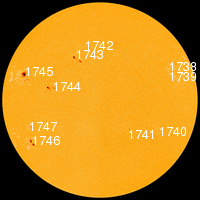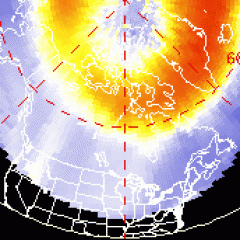SUNSET PLANETS: Venus, Jupiter and Mercury are gathering in the western sky for a beautiful sunset conjunction at the end of May. Get ready for a fantastic show. [full story] [video] [photo gallery]
STRONGEST FLARE OF THE YEAR: A sunspot hiding behind the sun's northeastern limb erupted on May 13th at 02:17 UT, producing the strongest solar flare of the year so far. NASA's Solar Dynamics Observatory recorded the extreme UV flash from the X1.7-class eruption:
Coronagraphs onboard the Solar and Heliospheric Observatory (SOHO) tracked a bright CME emerging from the blast site: movie. No planets were in the line of fire. However, the CME appears to be on course to hit NASA's Epoxi and Spitzer spacecraft on May 15th.
The sunspot that produced this blast is on the farside of the sun. Soon, in a few days, it will turn toward Earth, emerging into view over the sun's eastern limb. Stay tuned for a better view and, perhaps, more flares. Solar flare alerts: text, voice.

![]()
Solar wind
speed: 344.0 km/sec
density: 0.5 protons/cm3
explanation | more data
Updated: Today at 1555 UT
![]()
X-ray Solar Flares
6-hr max: X1 1600 UT May13
24-hr: X1 0217 UT May13
explanation | more data
Updated: Today at: 1600 UT
![]()
![]()
![]()
Daily Sun: 13 May 13
![]()
![]()
Sunspots AR1745 and AR1746 have 'beta-gamma' magnetic fields that harbor energy for M-class solar flares. Credit: SDO/HMI
![]()
![]()
![]()
Sunspot number: 173
What is the sunspot number?
Updated 13 May 2013
Spotless Days
Current Stretch: 0 days
2013 total: 0 days (0%)
2012 total: 0 days (0%)
2011 total: 2 days (<1%)
2010 total: 51 days (14%)
2009 total: 260 days (71%)
Since 2004: 821 days
Typical Solar Min: 486 days
Update 13 May 2013
The Radio Sun
10.7 cm flux: 147 sfu
explanation | more data
Updated 13 May 2013
![]()
![]()
![]()
Current Auroral Oval:
![]()
Switch to: Europe, USA, New Zealand, Antarctica
Credit: NOAA/POES
![]()
![]()
![]()
Planetary K-index
Now: Kp= 1 quiet
24-hr max: Kp= 1 quiet
explanation | more data
![]()
Interplanetary Mag. Field
Btotal: 6.4 nT
Bz: 4.1 nT south
explanation | more data
Updated: Today at 1557 UT
![]()
![]()
![]()
Coronal Holes: 13 May 13
![]()
![]()
There are no large coronal holes on the Earthside of the sun. Credit: SDO/AIA.





